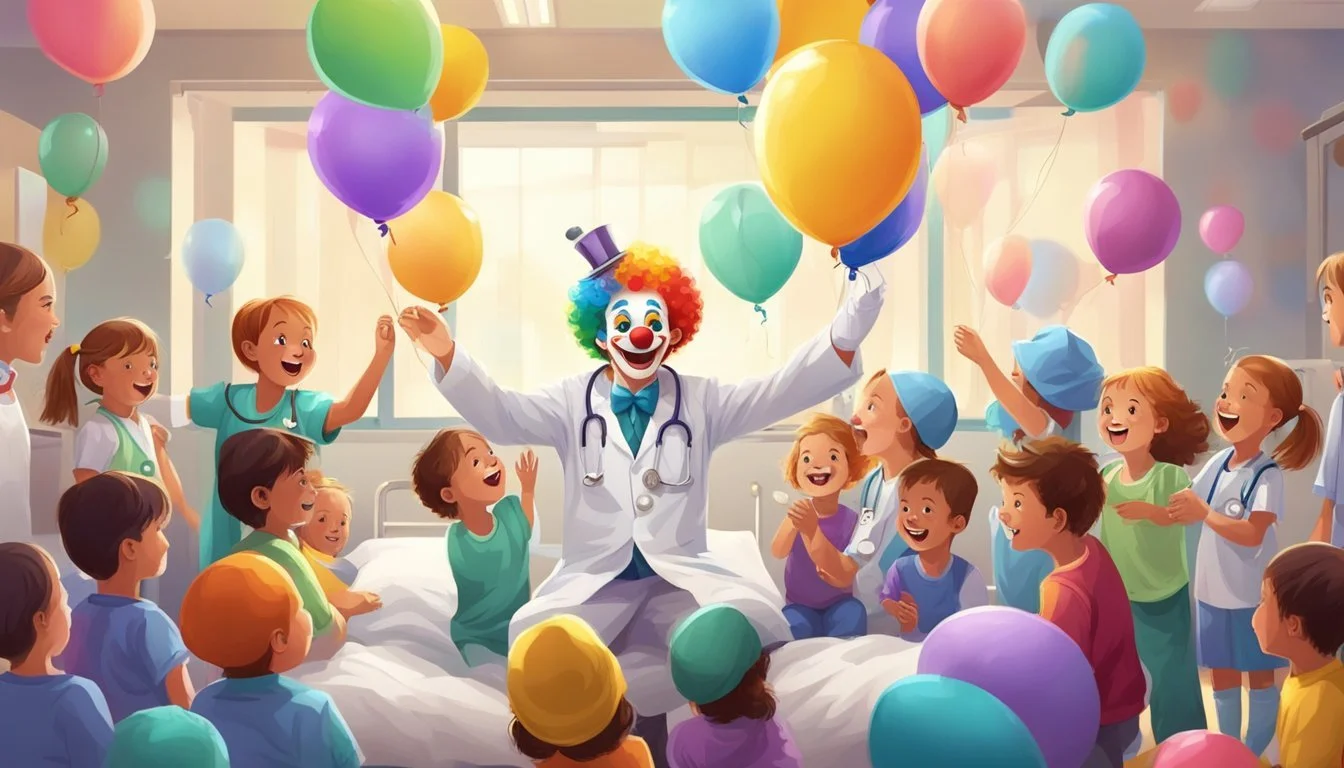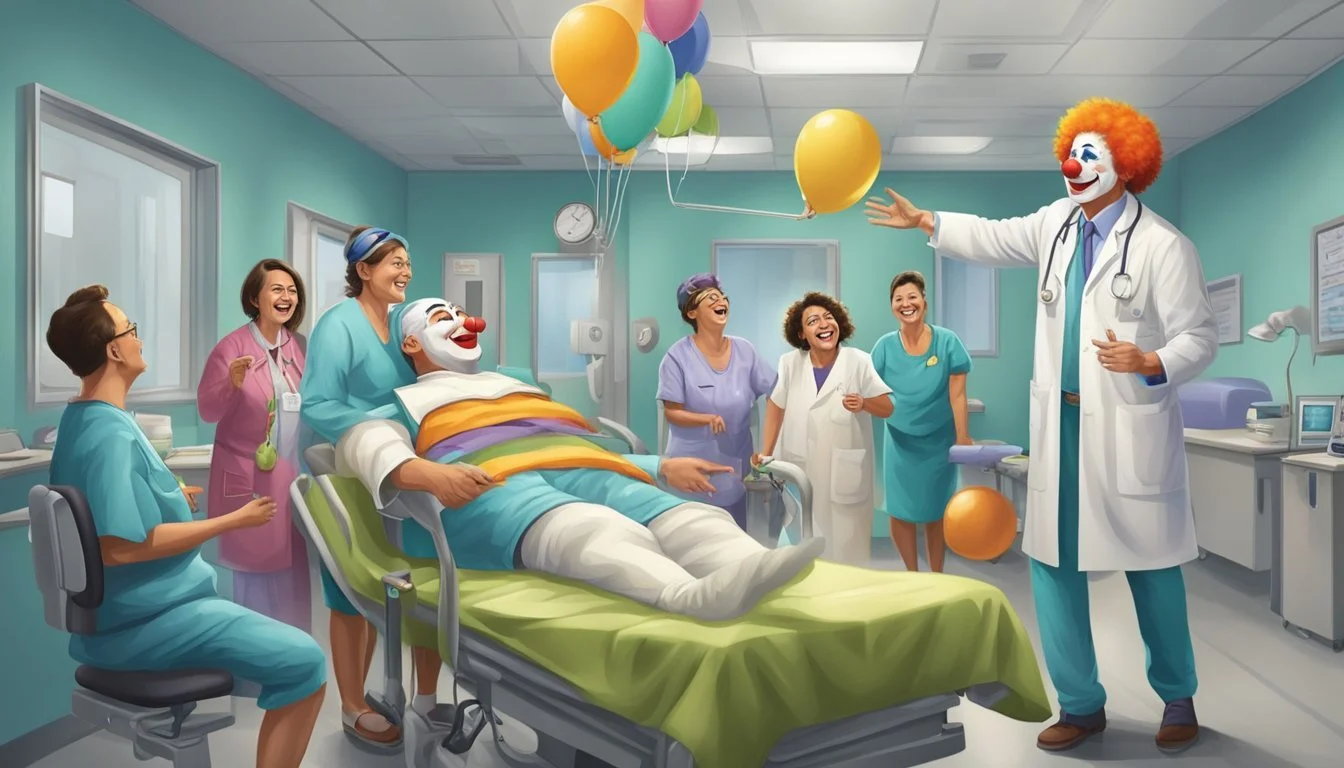The Real Patch Adams: Merging Medicine and Laughter
How Humor Revolutionizes Healthcare
Hunter Doherty "Patch" Adams revolutionized the medical field by combining humor with healthcare. Born in 1945, Adams faced personal struggles that led him to discover the healing power of laughter. His journey from a mental health patient to a pioneering doctor showcases the transformative potential of compassion in medicine.
Adams' unconventional approach to patient care emphasizes free treatment, extended initial consultations, and the integration of complementary therapies. His Gesundheit! Institute embodies these principles, treating patients as friends and prioritizing the human connection in healthcare. This model challenges traditional medical practices and advocates for a more holistic, patient-centered approach.
The 1998 film "Patch Adams," starring Robin Williams, brought Adams' story to a wider audience. While the movie took creative liberties, it captured the essence of Adams' mission to infuse joy and laughter into the healing process. Today, Adams continues to inspire healthcare professionals worldwide, reminding them of the importance of humor and empathy in patient care.
The Life and Legacy of Hunter 'Patch' Adams
Hunter 'Patch' Adams revolutionized healthcare by blending medicine with humor and compassion. His unconventional approach and dedication to social activism have left an indelible mark on the medical field.
Early Life and Motivations
Hunter Doherty Adams was born on May 28, 1945, in Washington, D.C. His father, a U.S. Army officer, died when Adams was 16, profoundly impacting his life.
As a young adult, Adams struggled with depression and attempted suicide. This experience led to his hospitalization in a mental institution, where he discovered his passion for helping others.
The time spent in the psychiatric ward inspired Adams to pursue a career in medicine. He realized the power of human connection and laughter in the healing process.
From Medical Student to Social Activist
Adams enrolled in medical school at Virginia Commonwealth University in 1967. He quickly gained a reputation for his unconventional methods and clown-like antics.
During his studies, Adams began wearing a red clown nose and colorful outfits to cheer up patients. He believed that laughter and joy were essential components of the healing process.
His unorthodox approach often clashed with traditional medical practices. Adams challenged the impersonal nature of healthcare and advocated for a more holistic, patient-centered approach.
Establishing the Gesundheit! Institute
In 1971, Adams founded the Gesundheit! Institute, a non-profit organization dedicated to revolutionizing healthcare. The institute's mission was to provide free, holistic medical care in a community setting.
Adams envisioned a healthcare model that combined traditional medicine with alternative therapies, humor, and social activism. The institute aimed to address not only physical ailments but also emotional and social well-being.
Despite financial challenges, the Gesundheit! Institute continues to operate today. It offers educational programs, workshops, and clown trips to various countries, spreading Adams' philosophy of compassionate care.
Medical Philosophy and Approach
Patch Adams developed a unique medical philosophy that intertwined humor, compassion, and unconventional approaches to patient care. His ideas challenged traditional healthcare norms and emphasized the importance of human connection in the healing process.
Integrating Humor with Medicine
Adams firmly believed in the therapeutic power of laughter. He incorporated clowning and comedic techniques into his medical practice, often wearing a red nose and colorful outfits during patient visits. This approach aimed to reduce stress, boost morale, and create a more positive healing environment.
Adams used jokes, magic tricks, and playful interactions to engage patients. He found that laughter could help alleviate pain, improve mood, and potentially speed up recovery. His methods extended beyond individual patient care to broader hospital settings, where he organized group activities and performances to spread joy.
Patient Care and the Role of Empathy
Empathy formed the cornerstone of Adams' medical philosophy. He advocated for treating patients as whole individuals rather than just focusing on their illnesses. This approach involved listening attentively, showing genuine concern, and building personal connections.
Adams encouraged longer patient visits to allow for meaningful interactions. He believed that understanding a patient's life circumstances, fears, and hopes was crucial for effective treatment. This empathetic approach often led to more accurate diagnoses and tailored treatment plans.
He also promoted physical touch, such as hugs or hand-holding, as a way to convey comfort and support. Adams argued that this human connection could be as important as traditional medical interventions in the healing process.
Challenges to Conventional Healthcare
Adams' unconventional methods faced criticism from the medical establishment. He challenged the impersonal, efficiency-driven nature of many healthcare systems. His approach prioritized quality of care over quantity of patients seen.
He advocated for free healthcare, believing that medical treatment should be accessible to all. This stance put him at odds with the profit-driven aspects of the healthcare industry. Adams founded the Gesundheit Institute to demonstrate his ideals in practice.
His critiques extended to medical education. Adams argued for more emphasis on compassion and communication skills in medical schools. He believed that doctors should be trained not just in scientific knowledge, but also in the art of human interaction and emotional support.
The Gesundheit! Project
The Gesundheit! Project represents Patch Adams' vision for revolutionizing healthcare through holistic practices, community involvement, and the therapeutic power of laughter. This innovative approach aims to create a more compassionate and effective medical system.
The Vision of Holistic Health Care
The Gesundheit Institute, founded by Patch Adams, seeks to redefine healthcare by treating the whole person - body, mind, and spirit. This holistic approach emphasizes the interconnectedness of individual health with family, community, and societal wellbeing.
The Institute's core principles include:
No-cost care for patients
No health insurance reimbursements
Extended initial patient interviews (3-4 hours)
Integration of alternative and allopathic medicine
Focus on preventive care and wellness education
These practices aim to create a more personalized and comprehensive healing environment, fostering deeper connections between caregivers and patients.
On the Road to a Rural Hospital
Patch Adams and his colleagues operated a pilot project for 12 years, serving 15,000 patients without charge. This experience laid the groundwork for their ambitious goal: building a 40-bed rural hospital in West Virginia.
The planned facility will feature:
Free, integrative healthcare
Eco-friendly design
Educational programs for medical professionals
Community outreach initiatives
Despite facing financial and logistical challenges, the team remains committed to realizing this dream and demonstrating a new model of healthcare delivery.
The Importance of Play and Joy in Healing
Central to the Gesundheit! Project is the belief that laughter, play, and joy are essential components of the healing process. Patch Adams, known for his clowning in hospitals, incorporates humor and playfulness into medical practice.
Key aspects of this approach include:
Using costumes and props to create a lighthearted atmosphere
Encouraging patients to engage in creative activities
Training healthcare providers in therapeutic clowning techniques
Research suggests that laughter can boost immune function, reduce stress, and improve pain tolerance. By prioritizing joy and human connection, the Gesundheit! Project aims to enhance patient outcomes and caregiver satisfaction.
Cultural Impact and the 'Patch Adams' Movie
The 1998 film "Patch Adams" starring Robin Williams brought widespread attention to the real-life doctor's unconventional approach to healthcare. It sparked discussions about the role of empathy and humor in medicine, influencing public perceptions of patient care.
Hollywood's Take: Robin Williams as Patch Adams
Robin Williams' portrayal of Patch Adams captivated audiences with his trademark humor and emotional depth. The film, directed by Tom Shadyac, took creative liberties with Adams' story, focusing on his medical school years and early career. Williams' performance highlighted Adams' use of comedy to connect with patients and challenge traditional medical practices.
The movie showcased memorable scenes of Adams using laughter therapy, dressing up as a clown, and advocating for more compassionate healthcare. While dramatized for cinematic effect, these depictions resonated with viewers and introduced Adams' philosophy to a global audience.
Influence on Public Perception of Healthcare
"Patch Adams" significantly impacted public views on medical care. The film popularized the idea of treating patients holistically, addressing emotional needs alongside physical symptoms. It encouraged viewers to question the often impersonal nature of healthcare and consider alternative approaches.
The movie's success led to increased interest in humanistic medicine and the therapeutic benefits of laughter. Many medical schools began incorporating courses on empathy and communication skills into their curricula. Some hospitals started clown therapy programs inspired by Adams' methods.
However, the film also faced criticism for oversimplifying complex medical issues and potentially setting unrealistic expectations for doctor-patient relationships. Despite these concerns, "Patch Adams" undeniably sparked important conversations about improving healthcare delivery and patient experiences.
Educational Outreach and Advocacy
Patch Adams expanded his impact beyond direct patient care through educational initiatives and advocacy efforts. He focused on transforming medical education and promoting a more compassionate healthcare system.
Workshops and Lectures Worldwide
Patch Adams traveled extensively, delivering lectures and workshops to diverse audiences. He spoke at medical schools, universities, and conferences in over 70 countries. His presentations emphasized the importance of humor, compassion, and human connection in healthcare.
Adams challenged conventional medical practices and encouraged students to think creatively about patient care. He often incorporated clowning techniques and interactive exercises into his workshops. These hands-on experiences helped participants develop empathy and communication skills.
His lectures addressed topics such as:
The healing power of laughter
Building meaningful doctor-patient relationships
Addressing social determinants of health
Integrating complementary therapies into medical practice
Promoting a Shift in Medical Education
Adams advocated for significant changes in medical education curricula. He believed traditional training methods focused too heavily on technical skills at the expense of developing compassionate caregivers.
Key aspects of Adams' proposed educational reforms included:
Emphasizing empathy and emotional intelligence
Incorporating arts and humanities into medical training
Promoting community engagement and social responsibility
Teaching stress management and self-care for healthcare providers
Adams collaborated with progressive medical schools to implement pilot programs. These initiatives integrated his principles into existing curricula. He also established mentorship programs, pairing experienced physicians with medical students to model compassionate care practices.
Healthcare and Social Initiatives
Patch Adams pioneered innovative approaches to healthcare delivery and community building. His efforts focused on expanding access to quality care and fostering trust between medical providers and patients.
Expanding Access to Quality Care
Adams founded the Gesundheit Institute, a non-profit organization dedicated to holistic healthcare. The institute aimed to provide free medical care to those in need. It operated on the principle that laughter and human connection are essential components of the healing process.
Adams envisioned a 40-bed hospital in West Virginia as part of the institute. This facility would offer integrative care combining traditional medicine with alternative therapies. The project faced funding challenges but remained a core part of Adams' vision for revolutionizing healthcare delivery.
The Gesundheit Institute also organized international clowning trips. These missions brought humor and medical care to underserved communities worldwide.
Building Community and Trust
Adams advocated for a communal ecovillage model of healthcare. This approach emphasized sustainable living and strong social bonds as foundations for well-being. The model aimed to create a supportive environment where patients and caregivers could form lasting relationships.
Trust-building was central to Adams' philosophy. He believed that genuine human connections were crucial for effective healthcare. Adams encouraged medical professionals to engage with patients on a personal level, using humor and empathy to break down barriers.
The Gesundheit Institute hosted workshops and seminars to promote these ideas. These events taught healthcare providers and community members about the importance of joy and laughter in healing.
Art, Creativity, and Healing
Patch Adams integrates art and creativity into his innovative approach to healthcare. He believes these elements are essential for promoting healing and well-being among patients.
Clowning as a Therapeutic Tool
Patch Adams pioneered the use of clowning as a therapeutic tool in medical settings. He dons a red nose and colorful attire to bring smiles to patients' faces. This unconventional method aims to reduce stress and anxiety in hospitals.
Clowning helps create a more positive atmosphere for healing. It can distract patients from pain and discomfort, even if only temporarily. Adams has trained thousands of healthcare professionals in clowning techniques.
Research suggests that laughter can boost immune function and release endorphins. These natural painkillers may aid in recovery. Clown therapy has shown promise in pediatric wards, where it can ease children's fears.
The Arts in Patient Recovery
Adams advocates for incorporating various art forms into patient care. Music therapy can reduce pain perception and improve mood. Visual arts allow patients to express emotions that may be difficult to verbalize.
Hospitals implementing art programs report increased patient satisfaction. Creative activities can provide a sense of control and normalcy during treatment. Some medical facilities now feature art galleries and performance spaces.
Dance and movement therapy help patients reconnect with their bodies. This can be especially beneficial for those with limited mobility. Writing and storytelling offer opportunities for patients to process their experiences.
Art therapy has shown positive results in mental health treatment. It can help individuals cope with trauma, depression, and anxiety. Adams encourages healthcare providers to embrace creativity as a healing tool.
Controversies and Critiques
Patch Adams' unconventional approach to medicine sparked debates within the healthcare community. His methods challenged traditional practices and drew both praise and criticism from various quarters.
Reactions from the Medical Community
Many allopathic doctors expressed skepticism about Adams' methods. They questioned the scientific basis of using humor as a primary treatment tool. Some medical professionals viewed his approach as trivializing serious health conditions.
Critics argued that Adams' focus on laughter might lead patients to neglect evidence-based treatments. They worried about the potential risks of prioritizing humor over established medical protocols.
Supporters, however, praised Adams for humanizing healthcare. They believed his methods could complement traditional treatments and improve patient outcomes.
Navigating the Tensions with Allopathic Medicine
Adams faced challenges integrating his alternative approach into mainstream healthcare systems. His emphasis on free care clashed with the economic realities of modern medicine.
Some medical institutions resisted Adams' ideas, citing concerns about liability and professional standards. They worried that his unconventional methods might undermine established medical practices.
Adams worked to bridge these gaps by collaborating with open-minded healthcare providers. He advocated for a balanced approach, combining humor with evidence-based treatments.
Despite ongoing tensions, Adams' work influenced discussions about patient-centered care and holistic healing approaches in medical education and practice.
Concluding Thoughts on Patch Adams' Influence
Patch Adams revolutionized the medical field with his unconventional approach. His emphasis on humor and human connection in healthcare remains influential today.
The Gesundheit Institute, founded by Adams, continues to promote his vision of compassionate care. This unique health care model prioritizes the emotional well-being of patients alongside their physical health.
Adams' work challenges traditional doctor-patient relationships. He advocates for forming friendships with patients, believing this enhances the healing process.
His passion for improving healthcare extends beyond hospital walls. Adams travels globally, spreading laughter and promoting his ideas about holistic care.
Critics argue that his methods lack scientific rigor. However, many patients and medical professionals appreciate the value of his human-centered approach.
Adams' influence has inspired medical schools to incorporate courses on empathy and communication. This shift recognizes the importance of emotional intelligence in healthcare.
While not universally adopted, Adams' ideas have sparked important conversations about patient care. His work continues to encourage medical professionals to consider the whole person, not just the illness.





